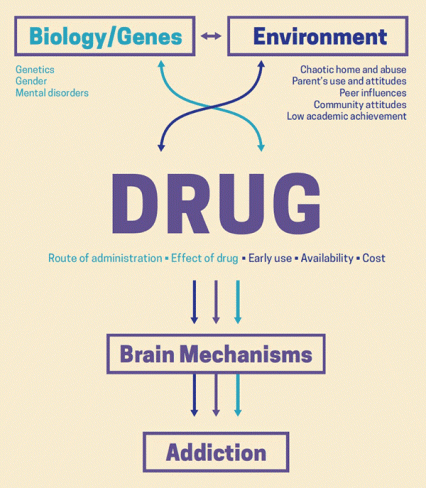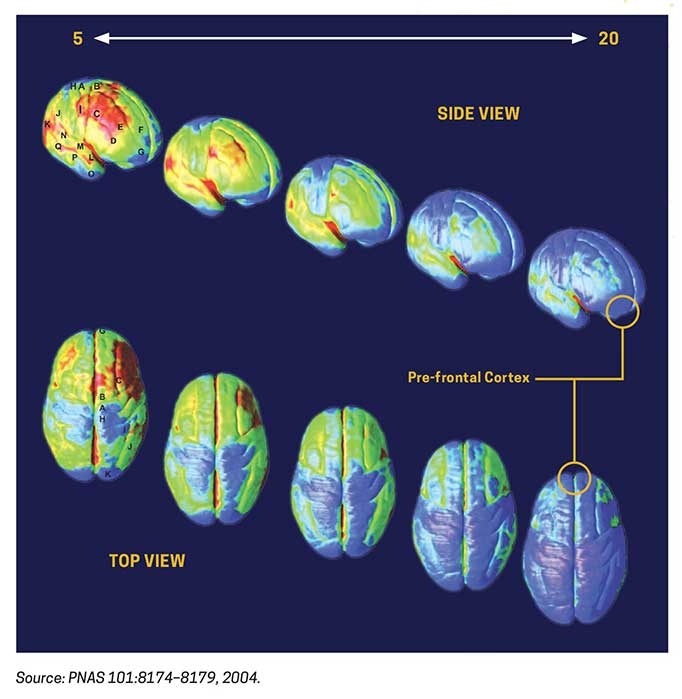What is drug addiction?
Addiction is defined as a chronic, relapsing disorder characterized by compulsive drug seeking and use despite adverse consequences.† It is considered a brain disorder, because it involves functional changes to brain circuits involved in reward, stress, and self-control. Those changes may last a long time after a person has stopped taking drugs.11
Addiction is a lot like other diseases, such as heart disease. Both disrupt the normal, healthy functioning of an organ in the body, both have serious harmful effects, and both are, in many cases, preventable and treatable. If left untreated, they can last a lifetime and may lead to death.
Note: These PET scans compare the brain of an individual with a history of cocaine use disorder (middle and right) to the brain of an individual without a history of cocaine use (left). The person who has had a cocaine use disorder has lower levels of the D2 dopamine receptor (depicted in red) in the striatum one month (middle) and four months (right) after stopping cocaine use compared to the non-user. The level of dopamine receptors in the brain of the cocaine user are higher at the 4-month mark (right), but have not returned to the levels observed in the non-user (left).
Why do people take drugs?
In general, people take drugs for a few reasons:
- To feel good. Drugs can produce intense feelings of pleasure. This initial euphoria is followed by other effects, which differ with the type of drug used. For example, with stimulants such as cocaine, the high is followed by feelings of power, self-confidence, and increased energy. In contrast, the euphoria caused by opioids such as heroin is followed by feelings of relaxation and satisfaction.
- To feel better. Some people who suffer from social anxiety, stress, and depression start using drugs to try to feel less anxious. Stress can play a major role in starting and continuing drug use as well as relapse (return to drug use) in patients recovering from addiction.
- To do better. Some people feel pressure to improve their focus in school or at work or their abilities in sports. This can play a role in trying or continuing to use drugs, such as prescription stimulants or cocaine.
- Curiosity and social pressure. In this respect, teens are particularly at risk because peer pressure can be very strong. Adolescence is a developmental period during which the presence of risk factors, such as peers who use drugs, may lead to substance use.
If taking drugs makes people feel good or better, what's the problem?

When they first use a drug, people may perceive what seem to be positive effects. They also may believe they can control their use. But drugs can quickly take over a person's life. Over time, if drug use continues, other pleasurable activities become less pleasurable, and the person has to take the drug just to feel “normal.” They have a hard time controlling their need to take drugs even though it causes many problems for themselves and their loved ones. Some people may start to feel the need to take more of a drug or take it more often, even in the early stages of their drug use. These are the signs of an addiction.
Even relatively moderate drug use poses dangers. Consider how a social drinker can become intoxicated, get behind the wheel of a car, and quickly turn a pleasurable activity into a tragedy that affects many lives. Occasional drug use, such as misusing an opioid to get high, can have similarly disastrous effects, including impaired driving and overdose.
Do people choose to keep using drugs?
The initial decision to take drugs is typically voluntary. But with continued use, a person's ability to exert self-control can become seriously impaired. This impairment in self-control is the hallmark of addiction.
Brain imaging studies of people with addiction show physical changes in areas of the brain that are critical to judgment, decision-making, learning and memory, and behavior control.12 These changes help explain the compulsive nature of addiction.
Why do some people become addicted to drugs, while others do not?
As with other diseases and disorders, the likelihood of developing an addiction differs from person to person, and no single factor determines whether a person will become addicted to drugs. In general, the more risk factors a person has, the greater the chance that taking drugs will lead to drug use and addiction. Protective factors, on the other hand, reduce a person's risk. Risk and protective factors may be either environmental or biological.
| Risk Factors | Protective Factors |
|---|---|
| Aggressive behavior in childhood13,14 | Self-efficacy (belief in self-control)15 |
| Lack of parental supervision14,16 | Parental monitoring and support16-18 |
| Low peer refusal skills13,17,18 | Positive relationships17,19 |
| Drug experimentation14,20,21 | Good grades17,22 |
| Availability of drugs at school21,23 | School anti-drug policies17 |
| Community poverty24,25 | Neighborhood resources26 |
What biological factors increase risk of addiction?
Biological factors that can affect a person's risk of addiction include their genes, stage of development, and even gender or ethnicity. Scientists estimate that genes, including the effects environmental factors have on a person's gene expression, called epigenetics, account for between 40 and 60 percent of a person's risk of addiction.27 Also, teens and people with mental disorders are at greater risk of drug use and addiction than others.28
What environmental factors increase the risk of addiction?
Environmental factors are those related to the family, school, and neighborhood. Factors that can increase a person's risk include the following:
- Home and Family. The home environment, especially during childhood, is a very important factor. Parents or older family members who use drugs or misuse alcohol, or who break the law, can increase children's risk of future drug problems.29
- Peer and School. Friends and other peers can have an increasingly strong influence during the teen years. Teens who use drugs can sway even those without risk factors to try drugs for the first time. Struggling in school or having poor social skills can put a child at further risk for using or becoming addicted to drugs.30
What other factors increase the risk of addiction?
- Early use. Although taking drugs at any age can lead to addiction, research shows that the earlier people begin to use drugs, the more likely they are to develop serious problems.31 This may be due to the harmful effect that drugs can have on the developing brain.32 It also may result from a mix of early social and biological risk factors, including lack of a stable home or family, exposure to physical or sexual abuse, genes, or mental illness. Still, the fact remains that early use is a strong indicator of problems ahead, including addiction.
- How the drug is taken. Smoking a drug or injecting it into a vein increases its addictive potential.33,34 Both smoked and injected drugs enter the brain within seconds, producing a powerful rush of pleasure. However, this intense high can fade within a few minutes. Scientists believe this powerful contrast drives some people to repeatedly use drugs to recapture the fleeting pleasurable state.
Images of Brain Development in Healthy Children and Teens (Ages 5-20)
The brain continues to develop into adulthood and undergoes dramatic changes during adolescence.
One of the brain areas still maturing during adolescence is the prefrontal cortex—the part of the brain that allows people to assess situations, make sound decisions, and keep emotions and desires under control. The fact that this critical part of a teen’s brain is still a work in progress puts them at increased risk for trying drugs or continuing to take them. Introducing drugs during this period of development may cause brain changes that have profound and long-lasting consequences.


